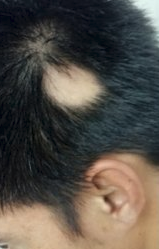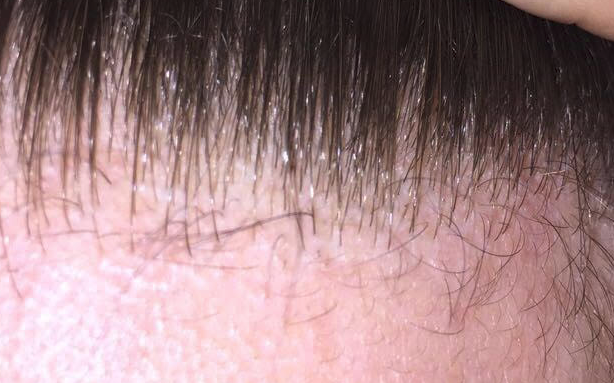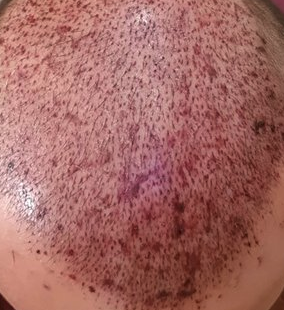Yes, with side effects that are so sever, I would do the surgery without finaasteride on board. I would alert you to the possible impact of shock loss, assuming you are over 25 years old. The only problem that you might see is some acceleration of your normal expected hair loss.
How often does someone lose grafts when washing their recipient area where the grafts were placed. I lost some grafts after my hair transplant, about 10 the very next day even though I followed the advice of my doctor. I used my fingers to gently rub the blood off. About 10 grafts came out. Maybe I was not gentle enough.
With proper washing techniques there should be no graft loss. The recipient area requires daily washes as well to keep the recipient area free of crusts. I generally recommend daily washing and if you washed it properly, there will be no crusts on it, even the very next day. We use a surgical sponge which we supply our patients, a surgical sponge to fill with soapy water and press on the recipient area daily. The shampoo and water squirt though the pores of the sponge and with these small jets of squirting liquid, the blood and crusts come off easily without disturbing the grafts as the sponge is pressed against the recipient area. By repeating this daily, all crusts can be washed off without any fear of losing grafts. If any crusts are present, use a Q tip and dip it into soapy water, and roll it on the crusts and that will lift the crusts off without dislodging the grafts, but never rub them, just roll the Q tip on the recipient crust. I like to see no evidence of any crusting in the recipient area and the crusts from the donor area gone in 7-10 days with daily washing.
losing hope, What should I do? 4 months of very aggressive shedding, 7 weeks on fin from tressless
The finasteride should reduce the shedding in 2-3 months and then other hair regrowth benefits may take up to 18 months after that so don’t lose hope,
My mother and aunt have a similar problem. What should I do?
Clearly you are very thin and have a see through appearance. If this is in the female side of your family, it is most likely genetic. First, you want to make sure that it is not caused by some medical condition.
Female hair loss is a difficult analysis and requires many tests, not just thyroid testing. I simply can not write a textbook on the subject on this site, but here’s a list of past posts that may help you understand what you’ve got going on:
- Female Genetic Hair Loss Is Different From Male Genetic Hair Loss
- Birth Control Pills and Hair Loss
- Woman With Thinning Hair After Family Tragedy
- Diseases Causing Women’s Hair Loss
- Female Hair Loss
The first step in evaluating hair loss in women, after a detailed history and physical exam, is to rule out any underlying medical causes of hair loss which can be treated. If clinically appropriate, the following disease processes should be considered: anemia, thyroid disease, connective tissue disease, gynecological conditions and emotional stress. Furthermore, over 50% of women going through change of life hormone fluctuations (menopause) experience significant hair loss. It is also important to review the use of medications that may cause hair loss, such as (but not limited to) oral contraceptives, beta-blockers, Vitamin A, thyroid drugs, coumadin, and prednisone. The following laboratory tests have been recommended to rule out the aforementioned medical conditions:
Some common blood tests for female hair loss:
- Sex Hormone tests
- SHBG (Sex Hormone Binding Globulin) used to test status of male hormones
- Estradiol is a sex hormone
- FSH (Follicle Stimulating Hormone) *not hair follicle but follicle in the ovary*
- LH (Luteinizing Hormone) is a sex hormone
- Free Testosterone
- Total Testosterone
- ANA (Anti Nuclear Antibody) used to test for Lupus or other autoimmune diseases
- TSH (Thyroid Stimulating Hormone) used to test for hyper or hypo-thyroid disease
- Test Iron status
- TIBC (Total Iron Binding Capacity)
- Ferritin
- Iron
Assuming that you do not have a medical cause and it is genetic female hair loss as seen in your aunt and mother, then one of the better cosmetic treatments for this is Scalp Micropigmentation: https://scalpmicropigmentation.com/smp-for-women/
Possibly. Usually as you get over 50, it is less effective because your testosterone is lower. A lower testosterone means that your DHT level is also lower as DHT is the metabolite of testosterone.
One of my patients did this search in Medical News Today. This is a kick off place for you to search further on the various subject below. The links are active below and many of these remedies have been addressed in previous balding blog posts over the years.
Apple cider vinegar for hair growth: Does it work?13 Sep 2017 What is apple cider vinegar and can apple cider vinegar boost hair growth? Learn if it is safe to use and what the proven health benefits of vinegar are.
Hair growth stimulated using stem cells14 Aug 2017 Using 3-D organoids made from stem cells, scientists managed to uncover a six-step process by which hair grows and stimulated hair growth.
Study provides new insights into male pattern baldness13 Jul 2017 New research maps hair growth patterns across the entire body, providing new insights into male pattern baldness and excessive hair growth.
Can I use vitamins for hair growth?12 Jul 2017 Health experts agree that eating a well-balanced diet that contains the 13 essential vitamins can help maintain the health of your hair.
Alopecia: Hair growth restored with new drug26 Sep 2016 Clinical trials conducted by Columbia University Medical Center find that JAK inhibitors may trigger hair regrowth in people with alopecia areata.
Drug promises robust new hair growth23 Oct 2015 Researchers have found that two drugs already approved by the FDA for other conditions can help strengthen hair growth, offering hope for people with baldness and alopecia.
Researchers generate new hair growth using human pluripotent stem cells 28 Jan 2015A new treatment for hair loss could be on the horizon; researchers have found a way to generate new hair growth using human pluripotent stem cells.
Mouse study finds immune system could promote hair growth 24 Dec 2014Cancer researchers have found an unexpected association between the macrophages of the immune system and regenerative skin stem cells.
Arthritis drug helps bald man grow full head of hair 20 Jun 2014Using an arthritis drug, doctors have restored hair growth in a 25-year-old man left bare of body hair from the uncommon disease alopecia universalis.
Signals That Prompt Hair Growth Discovered, May Pave Way For Baldness Treatment 05 Sep 2011Molecular signals that trigger hair growth have been discovered by scientists from Yale University, according to an article published in Cell.
Reversing Baldness – Clue May Lie In Stem Cell Signals That Trigger Hair Growth 02 Sep 2011By studying mice, researchers found that stem cells in the fatty layer of the skin send signals that trigger hair growth, and suggest the discovery could lead to new treatments for…
Adverse effects of common prostate enlargement and hair growth drugs: A review 26 Aug 2015Twenty-five percent of men currently taking Finasteride or Dutasteride, popularly known as Proscar and Avodart, for the treatment of benign prostate enlargement (BPH), appear not to benefit from…
To boldly go where few mice have gone before…27 May 2015Prolonged exposure to space conditions may induce skin thinning and cause profound alterations in the hair growth cycle according to a study in three mice published online in the first issue..
Positive clinical study results for Cellmid’s hair growth product using novel FGF5 inhibitor 17 Apr 2015Cellmid Limited has received strong positive results in all measured areas of its independently conducted, randomized, blinded and placebo controlled human clinical study of the évolis ONE…
Hair growth in mice promoted by honeybee hive sealant 16 Dec 2014Hair loss can be devastating for the millions of men and women who experience it.
What I would want to know is your hair character, its thickness and your donor density, all three are determined at an examination. Once I have that, I can determine what it would take to perform a hair transplant in terms of using up your donor supply which is limited. Your pattern of hair loss is a ‘high’ Class 6 pattern which means to me that the sides may come down as you age. It would be all part of my Master Plan to be able to work with you for the years to come as hair loss is progressive and you might not have yet seen where your hair loss will take you. i tell most men that they should not do a hair transplant until they are at least 25 years old and clearly you are older than that so that your present hair loss pattern is now evident? The key here is to set realiztic expectations with your surgeon.
Nipple soreness on Finasteride, quitting because of this, likely Gynecomastia and I don’t want that… is there anything else I can do? from tressless
If the nipple soreness went away, I doubt that gynecomastia will follow. Symptoms like this that come on, often disappear permanently once you maintain the drug. You might try to continue with the finasteride and see what happens or just speak with your doctor
The short hairs at the leading edge of your hairline are vellus hairs and these are normally present in everyone and evident when you zoom in on a frontal hairline as you have here. If you want to know if you are receding, I need to see a photo from the front with your eyebrows lifted high so the forehead creases. A normal mature hairline in a male, is one finger breadth above the highest crease.
So hair loss in men is 95% genetic MPB. How about hair loss in women? from tressless
You are correct that most hair loss in men is genetic. Women are far more complex as things like birth control pills, hormones, stress, genetic factors, thyroid disease ………. cause hair loss and these women often need extensive work-ups to find out the cause of their hair loss. Of interest, 50% of women post menopausal have genetic hair loss.
DUPA is extensive miniaturization in the donor area from the back and sides of your hair and it is found in some men. I am not aware of a connection between Vitamin deficiencies and this condition but if you are Vitamin deficient, address it with oral supplement.
These bumps you are referring to reflect that the grafts were elevated at the time the beard was transplanted and the skin of the graft healed above the level of the surrounding skin . There is nothing much you can do about this.
I am 25 years-old and had a hair transplant three months ago and all of my hair fell out that I had there before the transplant.
You developed shock loss after the surgery, a common event for young men. The prevention for this is the drug Finasteride which seems to work to prevent shock loss which can last almost a year after the surgery. Shock loss is an acceleration of the normal hair loss process and it is particularly dangerous for men in their 20s who have hair transplants.
Page 352 of 636






